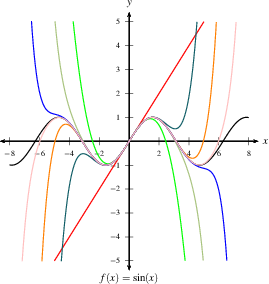
Home
The Fundamental Theorem of Calculus
Three Different ConceptsThe Fundamental Theorem of Calculus (Part 2)
The Fundamental Theorem of Calculus (Part 1)
More FTC 1
The Indefinite Integral and the Net Change
Indefinite Integrals and Anti-derivativesA Table of Common Anti-derivatives
The Net Change Theorem
The NCT and Public Policy
Substitution
Substitution for Indefinite IntegralsExamples to Try
Revised Table of Integrals
Substitution for Definite Integrals
Examples
Area Between Curves
Computation Using IntegrationTo Compute a Bulk Quantity
The Area Between Two Curves
Horizontal Slicing
Summary
Volumes
Slicing and Dicing SolidsSolids of Revolution 1: Disks
Solids of Revolution 2: Washers
More Practice
Integration by Parts
Integration by PartsExamples
Integration by Parts with a definite integral
Going in Circles
Tricks of the Trade
Integrals of Trig Functions
Antiderivatives of Basic Trigonometric FunctionsProduct of Sines and Cosines (mixed even and odd powers or only odd powers)
Product of Sines and Cosines (only even powers)
Product of Secants and Tangents
Other Cases
Trig Substitutions
How Trig Substitution WorksSummary of trig substitution options
Examples
Completing the Square
Partial Fractions
IntroductionLinear Factors
Irreducible Quadratic Factors
Improper Rational Functions and Long Division
Summary
Strategies of Integration
SubstitutionIntegration by Parts
Trig Integrals
Trig Substitutions
Partial Fractions
Improper Integrals
Type 1 - Improper Integrals with Infinite Intervals of IntegrationType 2 - Improper Integrals with Discontinuous Integrands
Comparison Tests for Convergence
Differential Equations
IntroductionSeparable Equations
Mixing and Dilution
Models of Growth
Exponential Growth and DecayLogistic Growth
Infinite Sequences
Approximate Versus Exact AnswersExamples of Infinite Sequences
Limit Laws for Sequences
Theorems for and Examples of Computing Limits of Sequences
Monotonic Covergence
Infinite Series
IntroductionGeometric Series
Limit Laws for Series
Test for Divergence and Other Theorems
Telescoping Sums and the FTC
Integral Test
Road MapThe Integral Test
Estimates of Value of the Series
Comparison Tests
The Basic Comparison TestThe Limit Comparison Test
Convergence of Series with Negative Terms
Introduction, Alternating Series,and the AS TestAbsolute Convergence
Rearrangements
The Ratio and Root Tests
The Ratio TestThe Root Test
Examples
Strategies for testing Series
Strategy to Test Series and a Review of TestsExamples, Part 1
Examples, Part 2
Power Series
Radius and Interval of ConvergenceFinding the Interval of Convergence
Power Series Centered at $x=a$
Representing Functions as Power Series
Functions as Power SeriesDerivatives and Integrals of Power Series
Applications and Examples
Taylor and Maclaurin Series
The Formula for Taylor SeriesTaylor Series for Common Functions
Adding, Multiplying, and Dividing Power Series
Miscellaneous Useful Facts
Applications of Taylor Polynomials
Taylor PolynomialsWhen Functions Are Equal to Their Taylor Series
When a Function Does Not Equal Its Taylor Series
Other Uses of Taylor Polynomials
Partial Derivatives
Visualizing Functions in 3 DimensionsDefinitions and Examples
An Example from DNA
Geometry of Partial Derivatives
Higher Order Derivatives
Differentials and Taylor Expansions
Multiple Integrals
BackgroundWhat is a Double Integral?
Volumes as Double Integrals
Iterated Integrals over Rectangles
How To Compute Iterated IntegralsExamples of Iterated Integrals
Cavalieri's Principle
Fubini's Theorem
Summary and an Important Example
Double Integrals over General Regions
Type I and Type II regionsExamples 1-4
Examples 5-7
Order of Integration
Taylor Polynomials
Probably the most important application of Taylor series is to use their partial sums to approximate
functions. These partial sums are (finite)
polynomials and are easy to compute. We call them Taylor polynomials.
| An $n^{th}$
degree Taylor polynomial is the polynomial of degree
$n$, consisting of the partial sum of the Taylor series up
to the $n^{th}$ power, denoted $T_n(x)$: $\begin{eqnarray} T_n(x)&=&f(a)+f'(a)(x-a)+\frac{f''(a)}{2!}(x-a)^2+\frac{f^{(3)}(a)}{3!}(x-a)^3+\cdots+\frac{f^{(n)}(a)}{n!}(x-a)^n\\ &=&\sum_{k=0}^n\frac{f^{(k)}(a)}{k!}(x-a)^k \end{eqnarray}$ |
We look at various Taylor polynomials:
T_1(x)&=&f(a) + f'(a) (x-a)\\
T_2(x)&=&f(a)+f'(a)(x-a)+\frac{f''(a)}{2!}(x-a)^2\\
T_3(x)&=&f(a)+f'(a)(x-a)+\frac{f''(a)}{2!}(x-a)^2+\frac{f^{(3)}(a)}{3!}(x-a)^3\\
&\vdots&\\
T_n(x)&=&f(a)+f'(a)(x-a)+\frac{f''(a)}{2!}(x-a)^2+\frac{f^{(3)}(a)}{3!}(x-a)^3+\cdots+\frac{f^{(n)}(a)}{n!}(x-a)^n
\end{eqnarray}$
You may recognize the first Taylor polynomial above. (Does it look familiar? Take a moment to think about this.) It is the linearization $L(x)$ of $f(x)$, which is just the equation of the tangent line of $f$ at $x=a$ that we used previously to approximate values of $f$ near $x=a$: $\quad f(x) \approx L(x) = f(a) + f'(a) (x-a)=T_1(x).$
Taylor polynomials extend the idea of linearization. To approximate $f$ at a given value of $x$, we will use $T_n(x)$ for a value of $n$ that gives a good enough approximation. We see from $T_n(x)$ above that we will need to find an $x$-value $a$ at which we can evaluate the derivatives of $f$. Our approximations get better the more terms we include, and they also allow us to get further from $a$ and still have a good approximation.Example: Find the Taylor polynomial of degree $7$
for $f(x)=\sin x$ centered at $x=0$.
Solution: We will compute this as if we didn't
already know the Taylor series for sine. We look at $T_n(x)$
above, and see we need to find evaluate $f(x)=\sin(x)$ and its
derivatives at $a=0$.
$\begin{array}{lll}
f(0)&=\sin(0)&=0\\
f'(0)&=\cos(0)&=1 \quad\text{ and then this pattern
repeats, so that }\\
f''(0)&=-\sin(0)&=0\\
f^{(3)}(0)&=-\cos(0)&=-1\\
\end{array}$ $\begin{array}{ll}
f^{(4)}(0)&=0\\
f^{(5)}(0)&=1\\
f^{(4)}(0)&=0\\
f^{(5)}(0)&=-1\\
\end{array}$
My calculator approximates $\sin(.5)=.4794255386$, and $T_7(.5)=.5-\frac{.5^3}{6}+\frac{.5^5}{120}-\frac{.5^7}{5040}=.4794255332$.
| This graphic shows $f(x)=\sin(x)$ in red,
then the linear approximations $T_1(x)$, $T_3(x)$, $T_5(x)$
and $T_7(x)$. You can see that as $n$ gets larger,
$T_n(x)$ matches the sine curve better, and matches it
farther from 0. cims.nyu.edu
|
 |
This is another graph of the same function, $f(x)=\sin(x)$, in black. This graph includes (unlabled) the Taylor polynomials that are in the graph above, with the addition of $T_9(x),T_{11}(x)$, and $T_{13}(x)$. |
 |
This video will compute approximations of $e^x$ and $\ln(x)$ near $a=0$, and $\sin x$ near $a=\frac{\pi}{4}$.